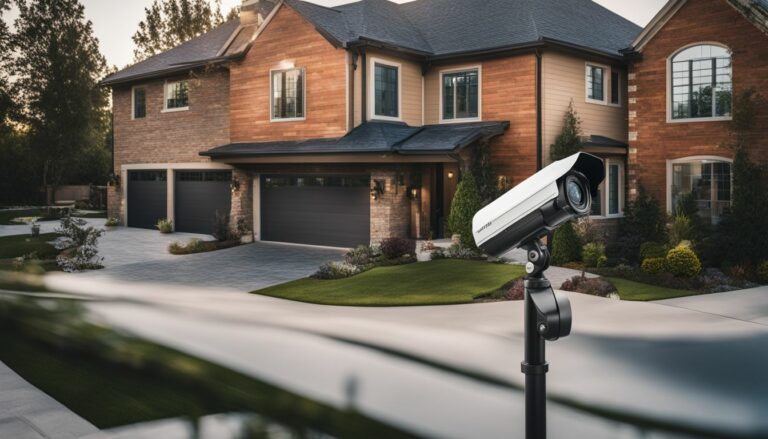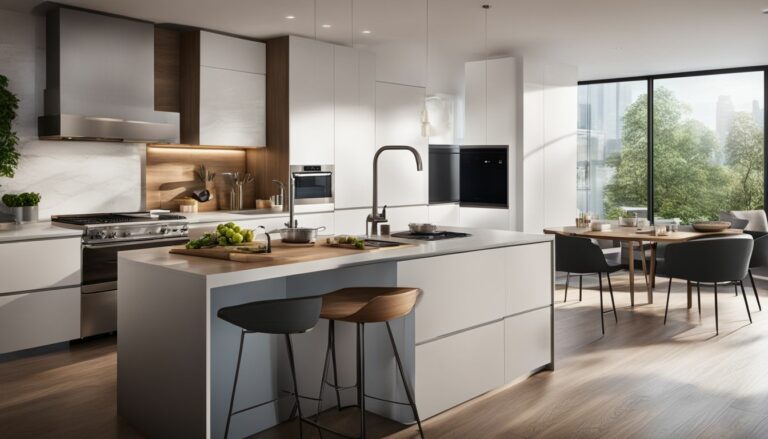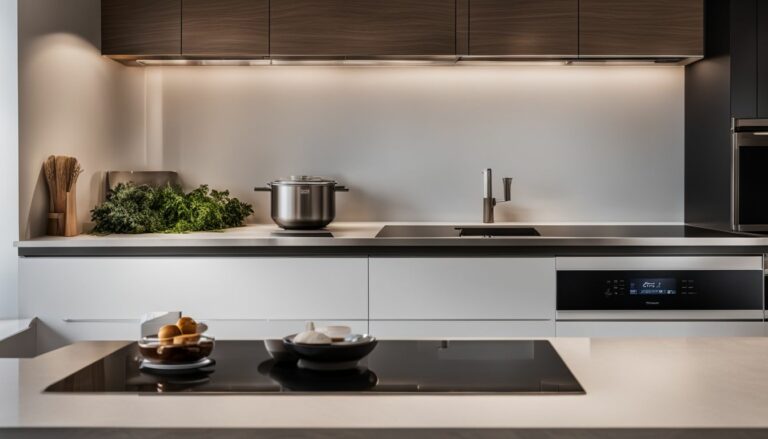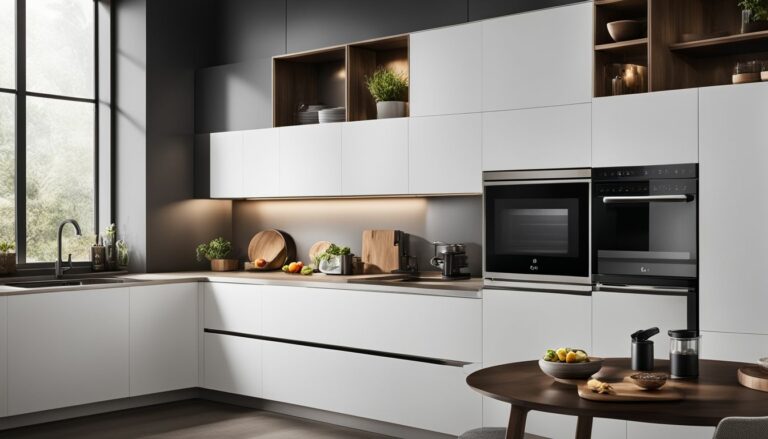Microwave Ovens: The Secret Weapon Every Busy Mom Needs | Top Picks from Best Buy & Home Depot
Microwave ovens have revolutionized the way we cook and prepare meals in our kitchens. These appliances offer a safe and easy-to-use option for heating and cooking various types of foods. With a spacious cooking chamber, they can accommodate a variety of cookware for versatile meal preparation. Using microwave energy, these ovens speed up cooking time by heating food from the inside out, providing a convenient and efficient solution for busy households. Found in most homes around the world, microwave ovens use a cavity magnetron to generate heat and cookware to contain the foods.
This article will guide you through the different types of ovens available, key features to consider when purchasing one, and tips on making the most out of it. Ready for a simpler way to choose your perfect microwave? Let’s dive in!
Feeling overwhelmed about selecting the right microwave oven for your kitchen? It’s interesting to know that microwaves, invented from radar technology, have been revolutionizing cooking since 1945.
Invention of the Microwave Oven
The microwave oven, a kitchen appliance that has revolutionized the way we cook and heat food, was invented by Percy Spencer in 1945.
| Microwave Ovens | |
|---|---|
| Inventor | Percy Spencer |
| Year | 1945 |
Percy Spencer, an American engineer and inventor, stumbled upon the idea of the microwave oven while working on radar technology during World War II. He noticed that a chocolate bar in his pocket had melted when he stood in front of a magnetron, a vacuum tube used in radar systems. This observation led him to experiment further, and he eventually developed the first microwave oven.
Microwave ovens work by using electromagnetic waves, specifically microwaves, to heat and cook food. These microwaves are generated by a magnetron, which converts electrical energy into microwave radiation. The microwaves are then directed into the oven cavity, where they interact with the water molecules present in the food. This interaction causes the water molecules to vibrate rapidly, generating heat and cooking the food.
The invention of the microwave oven brought about numerous benefits and conveniences in the kitchen.
How Do Microwave Ovens Work?
Microwave ovens are a staple in most kitchens today, providing a quick and convenient way to heat or cook food. But have you ever wondered how they actually work? In this section, we’ll dive into the inner workings of microwave ovens and explore the science behind them.
The Science Behind Microwaves
Microwave ovens work by using microwaves, which are a type of electromagnetic radiation. These microwaves have a specific frequency and wavelength that allows them to interact with water molecules, fats, and sugars in food. When the microwaves enter the oven, they are absorbed by the food, causing the molecules to vibrate rapidly and generate heat.
Inside the Microwave Oven
Inside a microwave oven, you’ll find a magnetron, which is the component responsible for generating the microwaves. The magnetron converts electrical energy into microwave radiation, which is then directed into the cooking chamber. The cooking chamber is made of a metal that reflects the microwaves, ensuring that they are contained within the oven.
The Cooking Process
When you place food in a microwave oven and set the desired cooking time and power level, the magnetron emits microwaves that penetrate the food. The microwaves cause the water molecules in the food to vibrate, generating heat. This heat then cooks or reheats the food from the inside out.
Safety Precautions
When using a microwave oven, it’s important to follow some safety precautions to prevent accidents or injuries. Here are a few tips to keep in mind:
- Use microwave-safe containers: Ensure that the containers you use are labeled as microwave-safe to avoid any potential hazards.
- Avoid metal objects: Metal can cause sparks and damage the oven, so it’s important to avoid using metal utensils or containers.
- Use microwave-safe covers: When reheating food, use microwave-safe covers or wraps to prevent splatters and maintain moisture.
Types And Features of Microwave Ovens
Microwave ovens, with their various models, have become an indispensable part of modern kitchens, offering convenience and efficiency in heating food. With various heating types and features available, it’s important to understand the heating options before making a heating purchase decision.
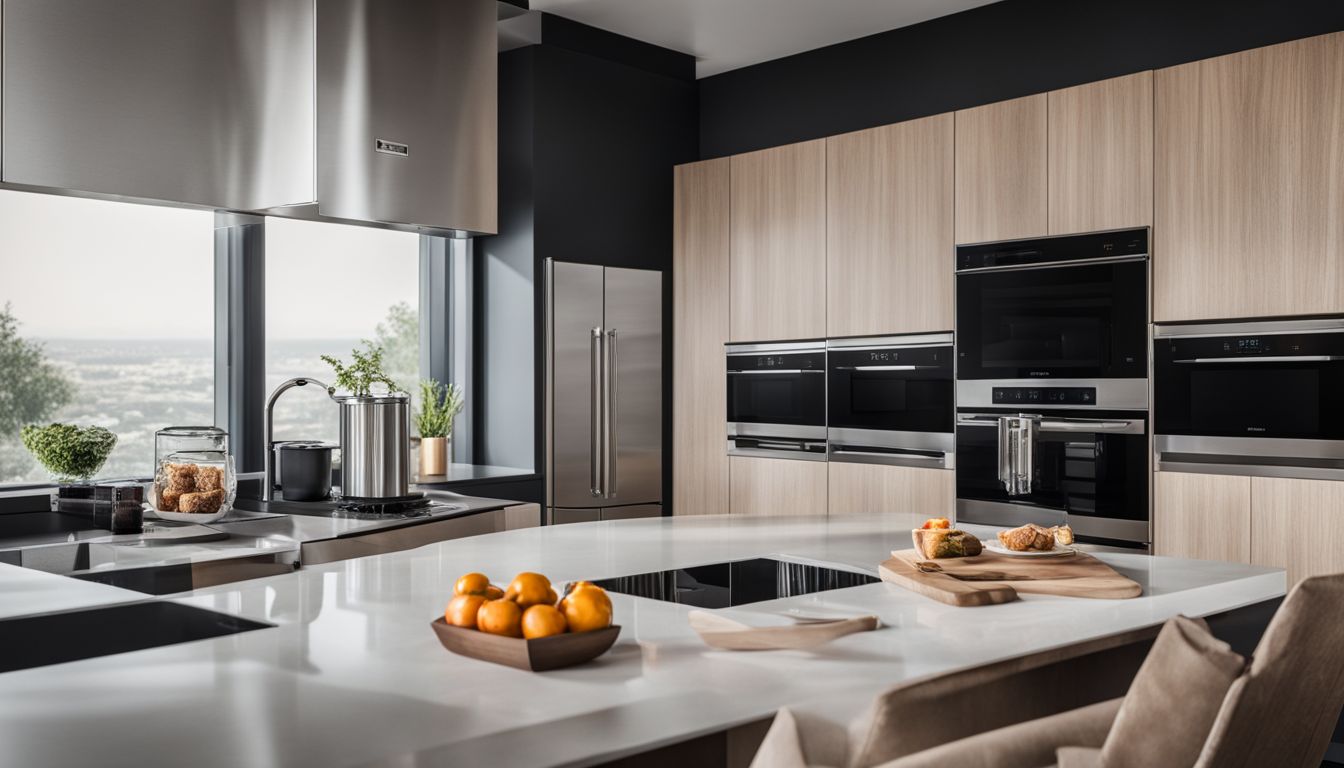
There are four main types of microwave ovens – countertop microwaves, built-in microwaves, convection microwaves, and over-the-range microwaves.
Countertop Microwave Models: Portable And Versatile
Countertop microwaves are the most common type found in households for heating purposes. These heating models are designed to sit on a countertop or any flat surface, providing portability and versatility for any kitchen layout. They come in different sizes to accommodate various cooking needs, including heating.
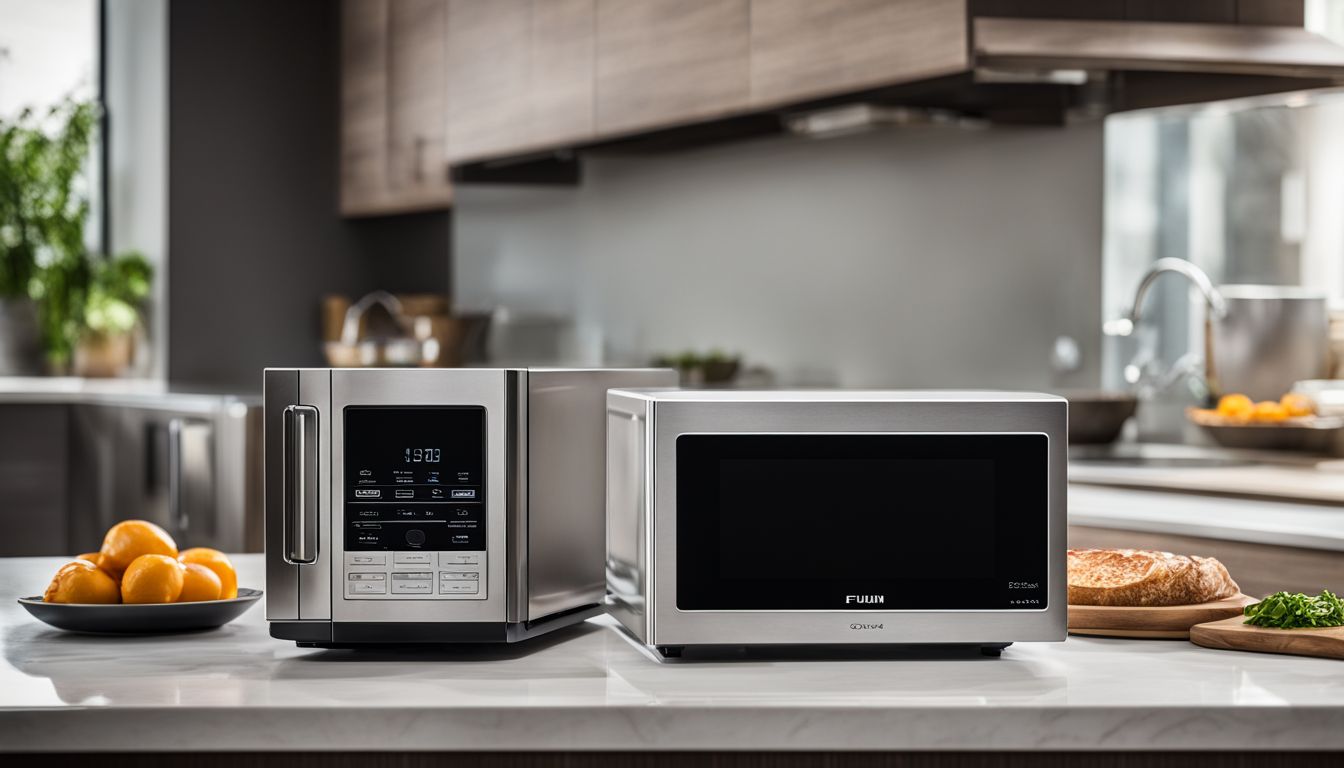
One of the advantages of countertop microwaves is their versatility in heating. They can be easily moved around if you decide to rearrange your kitchen setup. Whether you live in a small apartment or have limited counter space, these models offer flexibility without the need for heating installation.
Countertop microwaves are easy to use and fit well in any kitchen. You can plug them into a wall socket just like a toaster. They sit on your counter, ready for quick meals anytime.
These types of microwaves come in many shapes and sizes but they all need clear space around them for safe use. Countertop microwaves also have big doors that easily open with food trays inside.
People love these ovens because you can move them from place to place as needed.
Built-in Microwaves: Seamlessly Integrated Elegance

For a sleek and seamless look in your kitchen, built-in microwaves are the way to go. These models are specifically designed to be integrated into cabinetry or walls, creating a cohesive aesthetic appeal. Built-in microwaves blend seamlessly with other appliances and provide a high-end look.
Built-in microwaves are a popular choice for many people because they can be seamlessly integrated into your kitchen cabinets or wall units. They offer a streamlined and sleek look, making them perfect for modern kitchens.
These microwaves often come with trim kits that allow for precise installation within standard cabinetry dimensions. This integration not only saves valuable counter space but also adds a touch of sophistication to your kitchen design.
Built-in microwaves come in various sizes and styles to fit different kitchen layouts and design preferences.
One important thing to consider when buying a built-in microwave is the size. Measure the available space in your kitchen before purchasing to ensure it will fit properly. Another factor to consider is the wattage of the microwave, which determines how quickly it can cook food.
Higher wattage means faster cooking times.
Some built-in microwaves also come with additional features such as sensor cooking, auto defrost, and convection options. These features can make cooking more convenient and efficient.
Additionally, stainless steel finishes are popular choices for built-in microwaves as they complement other appliances in your kitchen.
Over-the-Range Microwaves: Space-Saving Solution
Over-the-range microwaves are a popular choice for many kitchens. These microwaves are designed to be installed above your stove or cooktop, saving valuable counter space. They usually come with built-in exhaust fans to help remove cooking odors and steam from your kitchen.
Over-the-range microwaves also have convenient features like preset cooking modes and sensor technology that adjusts the cooking time based on the food’s moisture levels. With their versatility and functionality, over-the-range microwaves offer a great solution for those looking to maximize space in their kitchen while still enjoying all the benefits of a microwave oven.
Convection Microwaves: The Best of Both Worlds
Convection microwaves combine the speed and convenience of microwave technology with the cooking capabilities of convection ovens. These versatile appliances use a combination of heat, circulated by fans, and microwave energy to cook food quickly and evenly.
The convection feature in these microwaves allows for browning, crisping, and baking, making them suitable for a wide range of recipes.
Summary And Comparison Table
| Microwave Type | Features |
|---|---|
| Countertop Models | – Portable and versatile |
| – Can be easily moved around | |
| – No installation required | |
| Over-the-Range Microwaves | – Space-saving solution |
| – Mounted above stove | |
| – Built-in ventilation system acts as range hood | |
| Built-In Microwaves | – Seamlessly integrated into cabinetry or walls |
| – Creates a cohesive aesthetic appeal | |
| – Comes with trim kits for precise installation | |
| Convection Microwaves | – Combines microwave technology with convection oven capabilities |
| – Uses heat and microwave energy to cook food quickly and evenly | |
| – Allows for browning, crisping, and bak |
Inverter Technology in Microwave Ovens
Inverter technology is a feature found in some modern microwave ovens that offers several advantages over traditional models. Rather than using a simple on/off system to generate heat, inverter technology allows for more precise control of the power output, resulting in more even and efficient cooking.
| Features | Pros | Cons | Differences |
|---|---|---|---|
| Precise Power Control | Allows for more accurate and consistent cooking results | May have a steeper learning curve for users accustomed to traditional microwaves | Inverter technology provides a wider range of power levels compared to traditional microwaves, allowing for greater control over cooking times and temperatures. |
| Even Heating | Ensures that food is cooked more evenly, reducing the risk of overcooking or undercooking | Can be more expensive than traditional microwave ovens | Traditional microwaves use a simple on/off system that can result in uneven heating, while inverter technology provides a constant level of power, resulting in more consistent cooking. |
| Energy Efficiency | Uses energy more efficiently, reducing electricity consumption | Initial cost may be higher compared to traditional microwaves | Inverter technology adjusts the power output based on the cooking requirements, resulting in less wasted energy and lower electricity bills. |
| Defrosting | Allows for more precise and uniform defrosting of frozen foods | May require adjusting cooking times and power levels for different types of food | Inverter technology provides a more gentle and controlled defrosting process, preventing the edges of the food from becoming partially cooked while the center remains frozen. |
Using inverter technology in microwave ovens offers several benefits, but it also requires some adjustments in cooking habits. With traditional microwaves, the power output is fixed, and cooking times are adjusted by cycling the power on and off. In contrast, inverter technology allows for precise control of the power level, resulting in more consistent cooking.
One of the main advantages of inverter technology is its ability to provide even heating. Traditional microwaves can sometimes leave cold spots or overcook certain areas of food. Inverter technology solves this problem by delivering a constant level of power, ensuring that the food is cooked uniformly.
In addition to even heating, inverter technology also offers energy efficiency. By adjusting the power output based on the cooking requirements, it uses energy more efficiently and reduces electricity consumption. This not only saves money on electricity bills but also contributes to a more sustainable lifestyle.
Another advantage of inverter technology is its ability to defrost frozen foods more evenly. Traditional microwaves often result in partially cooked edges and a still-frozen center when defrosting. Inverter technology provides a more controlled defrosting process, ensuring that the food thaws uniformly without any partially cooked areas.
While inverter technology offers significant advantages, it may have a steeper learning curve for those accustomed to traditional microwaves. Users may need to adjust their cooking times and power levels to achieve the desired results. However, with a little practice, the benefits of inverter technology can be fully enjoyed.
Benefits of Using Microwave Ovens in households
Microwave ovens, powered by a magnetron, have become an essential kitchen appliance for many households. They offer quick and convenient cooking and reheating of meals, thanks to their ability to generate high temperatures. With various models available, these ovens are especially useful for quickly heating water. Let’s explore some of the key advantages of using microwave ovens, which rely on magnetron technology to generate heat and quickly raise the temperature of food or water.
Saves time by quickly reheating leftovers or frozen meals
One of the most significant benefits of microwave ovens is their ability to save time in the kitchen when heating water for us. With just a few button presses, you can quickly reheat leftovers or frozen meals using microwave heating, without having to wait for a conventional oven to preheat. Microwave energy and radiation are used to rapidly increase the temperature. This feature is particularly handy when you’re in a rush or simply want to enjoy your meal without any unnecessary delays. It works by using conventional oven heat and temperature, as well as water and microwave radiation. It works by using conventional oven heat and temperature, as well as water and microwave radiation.
Preserves nutrients better than traditional cooking methods
Contrary to popular belief, microwave ovens are actually quite efficient at heating food and preserving the nutritional value of water. The temperature of the food is carefully controlled, allowing us to enjoy healthy meals. The heating effect produced by microwaves is different from traditional cooking methods as it heats food from within, rather than relying on external heat sources like stovetops or ovens. Microwaves use water to generate heat and cook the food efficiently. This unique cooking method has made microwave models popular in modern kitchens. Microwaves use water to generate heat and cook the food efficiently. This unique cooking method has made microwave models popular in modern kitchens. This helps retain more vitamins and minerals that may be lost during prolonged exposure to high temperatures, especially when using heating methods such as microwave energy. Additionally, using water in the heating process can also help preserve the nutrients. Furthermore, different models of microwaves may vary in their ability to retain these vital nutrients.

Reduces energy consumption compared to conventional ovens
Microwave ovens are known for their energy efficiency in heating water, making them a greener choice for environmentally conscious individuals. These models are particularly efficient in their heating capabilities. Unlike conventional ovens that require a considerable amount of time and energy to preheat, microwaves use less power and cook food faster due to their specific heating method. This makes them more efficient when it comes to saving water and energy. Additionally, microwaves are also preferred by many models for their quick cooking times. This makes them more efficient when it comes to saving water and energy. Additionally, microwaves are also preferred by many models for their quick cooking times. By opting for a microwave oven, you can reduce your overall energy consumption while still enjoying deliciously cooked meals. Microwave ovens use heating technology to cook food quickly and efficiently, saving water and energy compared to other cooking models. Microwave ovens use heating technology to cook food quickly and efficiently, saving water and energy compared to other cooking models.
Provides even heating for consistent results
Uneven heating can often be an issue when using conventional cooking methods such as stovetops or ovens, especially when cooking with water. However, modern cooking models have been designed to address this problem. However, microwave ovens provide even heating throughout the entire cooking chamber, ensuring consistent results every time you use them to cook with water. These appliances are especially useful for water-based recipes and can be relied upon to produce reliable results as they are designed using advanced water heating models. This means no more worrying about cold spots in your food or overcooking certain areas while leaving others undercooked. With our heating models, you can ensure that your food is evenly cooked throughout. With our heating models, you can ensure that your food is evenly cooked throughout.
Offers a range of cooking options, including defrosting and popcorn settings
Microwave ovens offer a variety of cooking options that go beyond just reheating leftovers. They can be used to quickly and efficiently heat up water for beverages or cooking. Additionally, these appliances come with different models that cater to various needs and preferences. They can be used to quickly and efficiently heat up water for beverages or cooking. Additionally, these appliances come with different models that cater to various needs and preferences. Many heating models come equipped with convenient features like defrosting settings, which allow you to thaw frozen water quickly and efficiently. Some microwave models even have specialized heating settings that take the guesswork out of achieving perfectly heated water.
Features to Consider When Buying a Microwave Oven
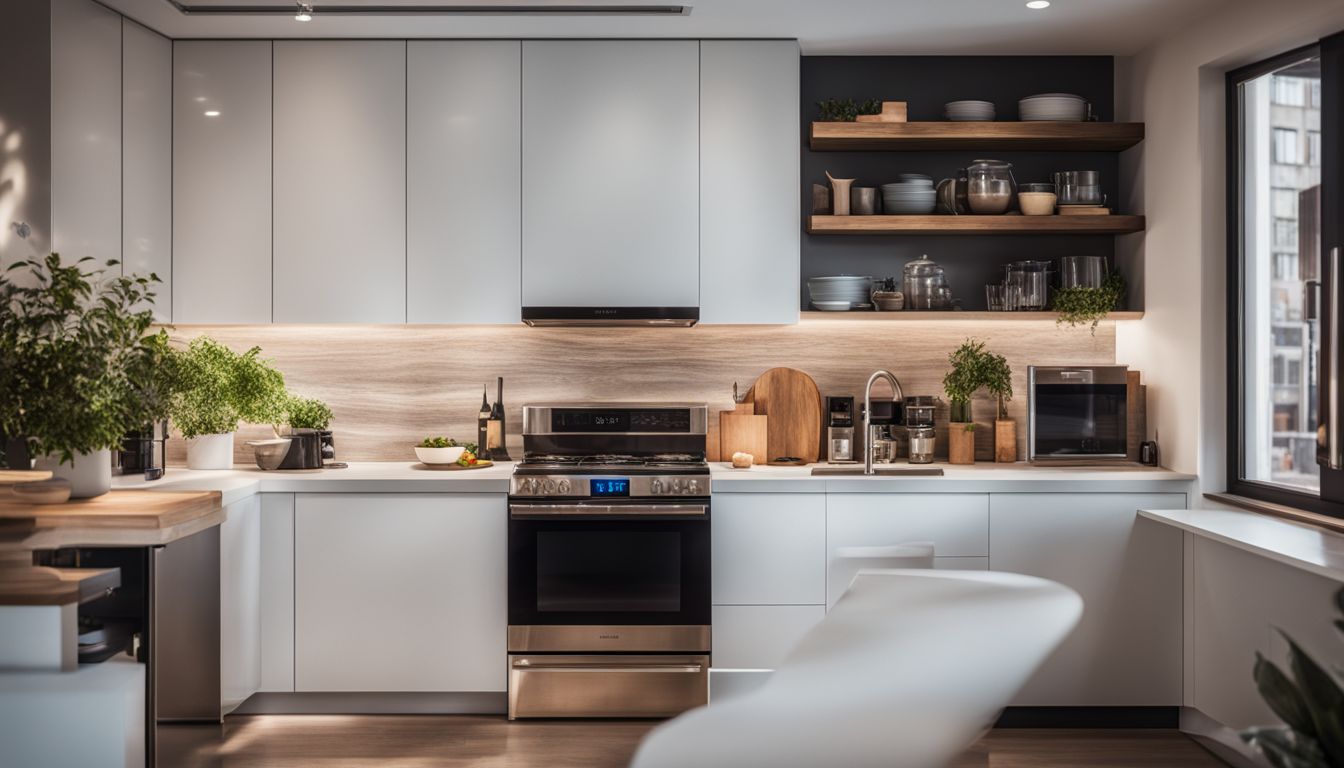
When buying a microwave oven, consider features such as wattage, capacity, cooking modes, safety features, and control panel options.
Wattage
The wattage of a microwave oven is an important factor to consider when buying one. The wattage determines how powerful the oven is and how quickly it can cook your food. A higher wattage means faster cooking times, while a lower wattage may result in longer cooking times.
Most microwave ovens have a range of wattages from 500 to 1200 watts. It’s essential to choose a wattage that suits your needs and cooking style. For example, if you often cook large portions or want fast heating, go for a higher wattage.
On the other hand, if you mostly use the microwave for simple tasks like reheating leftovers or making popcorn, a lower wattage might be sufficient. Consider your specific needs when selecting the right wattage for your microwave oven.
Capacity
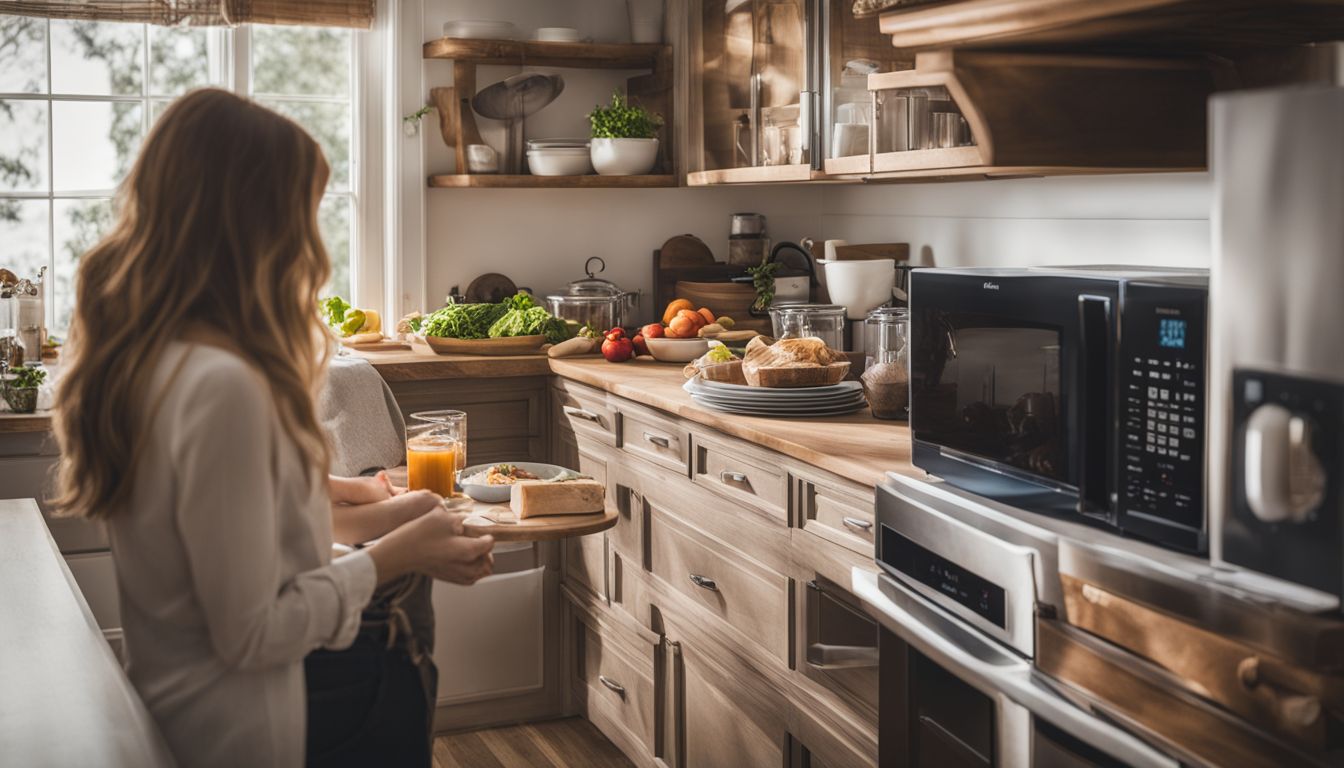
When choosing a microwave oven, one important feature to consider is its capacity. This refers to the amount of food that the microwave can hold and cook at once. Microwaves come in different sizes, typically measured in cubic feet.
A larger capacity means you can cook more food at a time, while a smaller capacity is better if you have limited kitchen space or only need to heat small portions. Keep in mind that the external dimensions of the microwave may not always reflect its internal cooking space.
So be sure to check the specifications and think about your cooking needs before making a decision. Remember, it’s always better to have a bit more capacity than you think you’ll need, so you don’t run into any limitations when preparing meals for yourself or your family.
Cooking Modes
Microwave ovens come with different cooking modes that provide versatility in preparing various types of food. One common cooking mode is the “defrost” setting, which helps thaw frozen items quickly and evenly.
Another useful mode is “reheat,” which warms up leftovers without drying them out. Some microwave ovens also have a “sensor cook” feature that automatically adjusts the cooking time based on the food’s moisture content or weight, ensuring optimal results.
Additionally, there are preset modes for popcorn, beverages, and specific types of food like pizza or vegetables. These cooking modes make it easier to prepare meals efficiently and reduce the guesswork when using a microwave oven.
Safety Features
Microwave ovens come with important safety features that help protect you and your home. One common safety feature is the child lock, which prevents young children from accidentally turning on the microwave or interfering with the cooking process.
Another safety feature is the door latch or sensor, which ensures that the microwave stops working when the door is open. This helps prevent accidents and burns. Some microwaves also have overheating protection, which automatically shuts off the oven if it gets too hot.
These safety features are designed to give you peace of mind while cooking and using your microwave oven safely in your kitchen.
Control Panel Options
Microwave ovens come with different control panel options to make it easier for you to use them. Some microwaves have simple manual dials that allow you to adjust the cooking time and power level.
Others have digital touchpad controls that give you more precise settings and additional features like preset cooking modes. You can also find microwaves with sensor cooking, where the microwave automatically detects when your food is done based on steam or heat levels.
These control panel options give you more flexibility and convenience in using your microwave oven.
Choosing the Best Microwave Oven for Your Needs
Consider your available space and choose between countertop, over-the-range, or built-in models accordingly.
Consider your cooking style, kitchen space, budget, and preferred brand to find the perfect microwave oven for you. One of the first factors to consider is the available space in your kitchen. Depending on your kitchen layout and personal preferences, you can opt for a countertop, over-the-range, or built-in model.
- Countertop Microwaves: These are the most common type of microwaves and are designed to sit on a countertop or any flat surface. They offer convenience and portability as they can be easily moved around if needed. Countertop microwaves come in various sizes, so make sure to measure the space where you plan to place it before making a purchase.
- Over-the-Range Microwaves: If you have limited counter space or prefer to save room, an over-the-range microwave might be the ideal choice for you. These microwaves are installed above your stovetop and feature ventilation systems that eliminate cooking odors and smoke. They typically come with built-in exhaust fans as well.
- Built-In Microwaves: Built-in microwaves are designed to seamlessly integrate into your kitchen cabinetry or wall unit. They provide a sleek and cohesive look while maximizing counter space. However, keep in mind that installing a built-in microwave may require professional assistance due to electrical wiring and precise measurements.
Cooking Style and Frequency
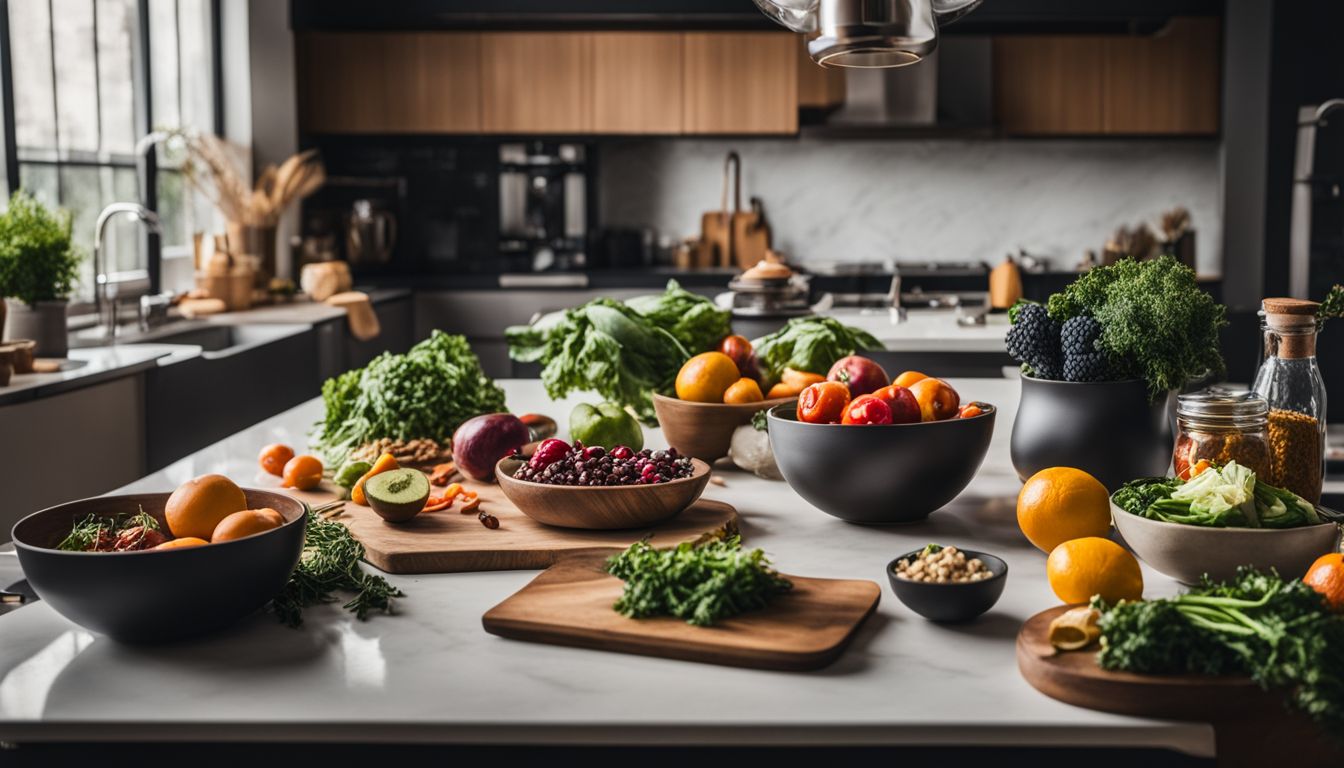
Determine the desired capacity based on your typical food preparation needs.
Another important aspect when choosing a microwave oven is determining its capacity based on your typical food preparation needs. The size of the cooking chamber directly affects how much food you can heat or cook at once.
Are you someone who loves to cook and is always experimenting with new recipes? Or perhaps you prefer quick and easy meals that require minimal effort? Your cooking style and frequency are important factors to consider when choosing a microwave oven.
- Small Capacity: Microwaves with smaller capacities (less than 1 cubic foot) are suitable for individuals or small households who primarily use their microwave for reheating leftovers or heating single portions of food. They are also a good choice for those with limited kitchen space.
- Medium Capacity: Microwaves with medium capacities (1 to 1.5 cubic feet) can accommodate larger dishes and are ideal for small families or individuals who frequently cook meals in their microwave oven.
- Large Capacity: If you often entertain guests or have a large family, a microwave with a larger capacity (1.6 cubic feet and above) will be more suitable.
If you’re a regular cook who enjoys preparing elaborate meals, you might benefit from a microwave with more advanced features like multiple cooking modes and a higher wattage for faster heating.
On the other hand, if you only use your microwave occasionally for reheating leftovers or making simple snacks, a basic model with lower wattage might be sufficient. Consider your cooking habits and needs before making a decision.
Kitchen Space and Layout
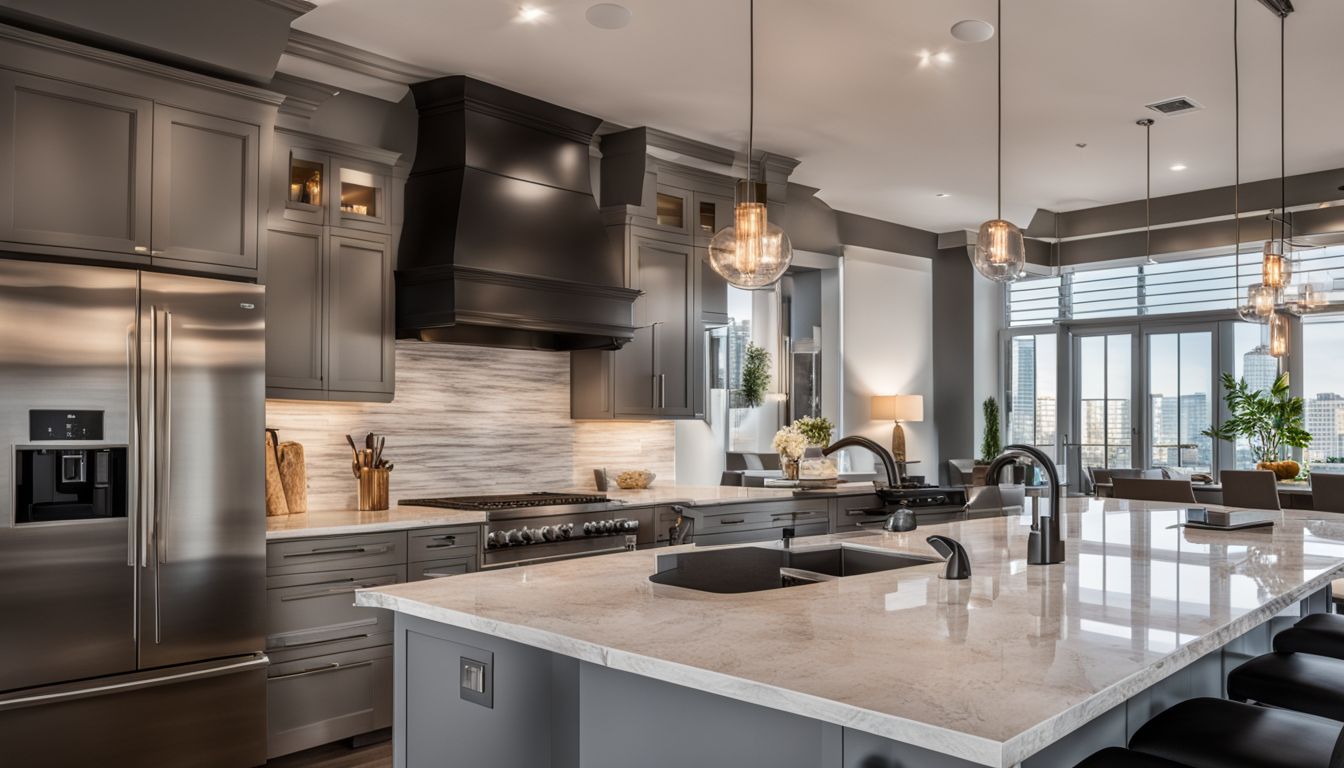
Consider your kitchen space and layout when choosing a microwave oven. Measure the available countertop or cabinet space to ensure that the microwave will fit properly. If you have limited counter space, a built-in or over-the-range microwave may be a better option for you.
Additionally, think about how the microwave will be used in your kitchen workflow. Placing it near other cooking appliances can make it more convenient to use while preparing meals.
Take into account these factors to find the best microwave oven that suits both your kitchen space and layout needs.
Budget

When it comes to choosing a microwave oven, your budget is an important factor to consider. Microwaves can vary in price, ranging from affordable options to more expensive models with advanced features.
It’s essential to determine how much you’re willing to spend before making a purchase. Keep in mind that higher-priced microwaves often come with additional functions and larger capacities.
However, there are also budget-friendly options available that can still meet your basic cooking needs. Consider your kitchen needs and prioritize the features that are most important to you within your budget range.
Brand and Warranty

When choosing the best microwave oven for your needs, it’s important to consider the brand and warranty. Look for reputable brands that have a good track record of producing reliable appliances.
A trusted brand is more likely to offer better quality and performance. Additionally, check the warranty offered by the manufacturer. A longer warranty period can give you peace of mind knowing that you’re covered if any issues arise with your microwave oven.
Some brands even offer extended warranties or additional coverage options for an extra cost. Remember, investing in a reputable brand with a solid warranty can save you from potential headaches down the line.
Tips for Getting the Most out of Your Microwave Oven
Maximize the functionality of your microwave oven by properly using and caring for it, cleaning and maintaining it regularly, utilizing cooking tips and tricks, and ensuring you use microwave-safe cookware.
Proper Use and Care

Proper use and care of your microwave oven are important to ensure its longevity and safe operation. Here are some tips to help you get the most out of your microwave:
- Place a microwave – safe dish or container inside the oven before heating food.
- Use microwave – safe cookware, such as glass or ceramic, to prevent damage and avoid chemicals leaching into your food.
- Stir or rotate your food during cooking for even heat distribution.
- If using plastic wrap, make sure it does not touch the food to prevent melting and potential chemical leaching.
- Avoid using metal utensils or foil inside the microwave, as they can cause sparks and damage the oven.
- Clean spills and splatters promptly with mild soap and water to avoid buildup that can affect performance.
- Regularly wipe down the interior with a damp cloth to remove any lingering odors or stains.
- Do not operate the microwave if the door is damaged or doesn’t close properly, as this can pose safety risks.
- Keep the exterior clean by wiping it down with a soft cloth dampened with water or a mild household cleaner.
- Follow manufacturer’s instructions for maintenance tasks such as replacing filters or light bulbs.
- Microwaves have three characteristics that allow them to be used in cooking: they are reflected by metal, they pass through glass and paper, and they are absorbed by water and fats.
- The process of dielectric heating occurs in a microwave oven, where polar molecules in the food rotate and produce thermal energy.
Cleaning and Maintenance
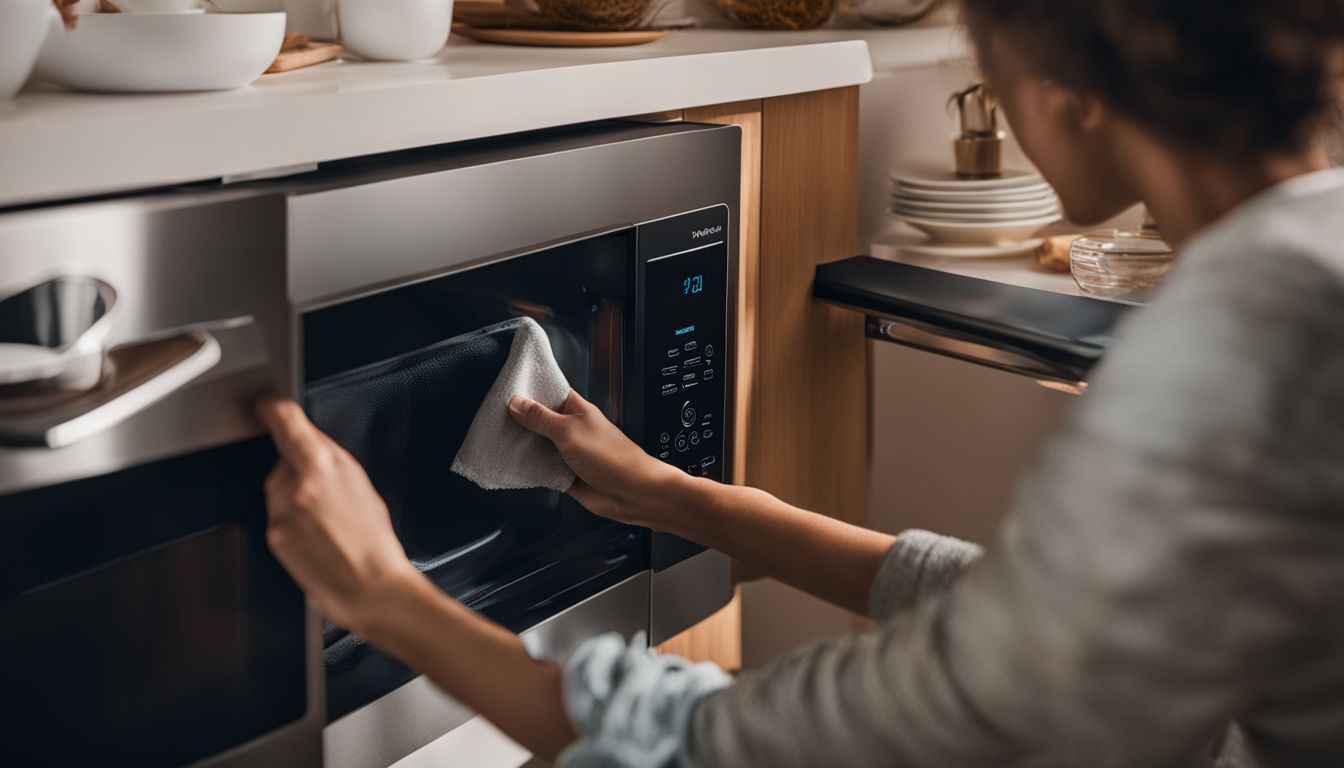
Cleaning and maintaining your microwave oven is important to ensure it works properly and lasts longer. Here are some tips:
- Regularly wipe down the interior with a damp cloth or sponge to remove any food splatters or spills.
- For stubborn stains or odors, you can use a mixture of water and mild dish soap to clean the interior.
- Avoid using abrasive cleaners or scrub brushes that could damage the interior surfaces.
- To clean the exterior, simply wipe it down with a clean cloth or sponge and mild soap.
- Pay attention to the control panel and buttons, making sure they are free from dirt and grime.
- Remove and wash the microwave’s turntable tray regularly to keep it clean and hygienic.
- Make sure to unplug the microwave before cleaning any electrical components, such as vents or fans.
- Check and clean the air vents regularly to prevent blockages that could affect the microwave’s performance.
- It’s important to follow any specific cleaning instructions provided by the manufacturer in your microwave’s user manual.
- Regular maintenance includes checking for any signs of damage, such as frayed cords or faulty door seals, and addressing them promptly.
Cooking Tips and Tricks
Cooking with a microwave oven can be quick and easy. Here are some tips and tricks to get the most out of your microwave:
- Use microwave-safe cookware: Make sure the dishes you use in the microwave are labeled as microwave-safe to avoid melting or releasing harmful chemicals into your food.
- Stir or rotate food: To ensure even cooking, stir or rotate your food halfway through the cooking time. This helps prevent hot spots and ensures that all parts of the dish are evenly heated.
- Cover food when reheating: When reheating leftovers or liquids in the microwave, cover them with a lid or microwave-safe plastic wrap. This helps trap steam and prevents splattering.
- Cut food into small pieces: Cutting food into smaller pieces helps it cook more quickly and evenly in the microwave. This is particularly important for larger items like potatoes or chicken breasts.
- Add moisture if needed: Some foods, like bread or pastries, can become dry when heated in the microwave. To prevent this, add a small amount of water to create steam and keep your food moist.
- Adjust cooking times: Microwaves vary in power, so you may need to adjust cooking times accordingly. Start with shorter cooking times and increase if necessary to avoid overcooking your food.
- Let it stand: After microwaving, let your food stand for a few minutes before removing it from the oven. This allows for additional heat distribution and helps ensure that your food is cooked through.
Microwave-Safe Cookware
When using a microwave oven, it’s important to use cookware that is safe for this type of cooking. Microwave-safe cookware is designed to withstand the high temperatures and intense heat generated by the microwave.
It is made from materials that do not react or melt when exposed to microwaves. Some examples of microwave-safe cookware include glass, ceramic, and certain types of plastic containers labeled as microwave-safe.
It’s crucial to check the manufacturer’s instructions before using any cookware in the microwave to ensure its safety. Using non-microwave-safe materials can result in food contamination or damage to both the cookware and the oven itself.
The Convenience and Considerations of Microwave Ovens
Microwave ovens have become an essential kitchen appliance in today’s fast-paced lifestyle. They offer quick meal solutions, allowing us to heat food in a matter of seconds rather than waiting for traditional cooking methods. However, while microwave ovens provide convenience, there are a few considerations that need to be kept in mind.
One of the main concerns with microwave ovens is uneven heating. Due to the way microwaves work, some areas of the food may heat up faster than others, leading to hot spots and cold spots. This can result in an inconsistent cooking experience and may require stirring or rearranging the food during the cooking process. Microwave ovens have limited browning capabilities compared to conventional ovens or stovetop cooking methods. If you desire a crispy or browned texture on your food, using a convection oven or other traditional methods might be more suitable.
Proper use of microwave-safe containers is essential when using microwave ovens. It is important to choose containers made specifically for microwave use as certain plastics can release harmful chemicals when subjected to high temperatures. Always check for labels indicating that the container is safe for microwave use before placing it inside the oven. This consideration helps avoid potential health risks associated with exposure to harmful substances.
Regular cleaning of your microwave oven not only helps maintain its optimal performance but also prevents odors from lingering inside the appliance. Food particles can accumulate over time and affect both taste and smell if not cleaned properly. A simple solution of water and mild detergent can be used to wipe down the interior surfaces regularly. Placing a bowl filled with water and lemon juice inside the oven and running it for a few minutes will help eliminate any stubborn odors.
To prevent sparks or damage, it is crucial to avoid using metal objects or aluminum foil inside microwaves. Metal reflects microwaves which can lead to electrical arcing and potentially cause a fire hazard. It is best to use microwave-safe cookware, such as glass or ceramic dishes, when heating food in the microwave. Always double-check that the container you are using does not have any metallic elements, including decorative trim or handles.
There are several features and options available. Different brands offer various models with unique functionalities to cater to different needs.
what are the best microwave ovens to buy
When it comes to choosing the best microwave oven, there are several factors to consider. Some of the top microwave ovens on the market include the Panasonic NN-SN966S, the Toshiba EM925A5A-BS, and the Breville Quick Touch, Samsung, Whirlpool, LG, GE, and more. These models are highly rated for their performance, features, and durability.
The Panasonic NN-SN966S is a convection microwave that offers the best of both worlds. It combines the speed and convenience of a microwave with the cooking capabilities of a convection oven. This allows you to quickly heat up or defrost food, while also being able to bake, roast, and grill with ease. The Panasonic NN-SN966S also has a large capacity, making it perfect for families or those who like to cook in larger quantities.
Another great option is the Toshiba EM925A5A-BS. This microwave oven is known for its compact size and sleek design. It offers a variety of useful features, such as a sensor cooking function that automatically adjusts cooking time and power level based on the food being cooked. The Toshiba EM925A5A-BS also has a child safety lock, making it a great option for families with young children.
For those who want a high-end microwave oven, the Breville Quick Touch is a top choice. This model is packed with advanced features, including a smart menu that provides pre-programmed settings for popular dishes. The Breville Quick Touch also has a unique “A Bit More” button, which allows you to add a little extra cooking time to your dish if needed. Additionally, this microwave oven has a large LCD display and is made with high-quality materials for long-lasting durability.
GE Countertop Microwave Oven: Specifications and Versatility
The GE countertop microwave oven is a versatile kitchen appliance that offers a range of features to make your cooking experience easier and more convenient. With its compact size, measuring just 0.7 cubic feet, this microwave is perfect for small kitchens or dorm rooms where space may be limited.
One of the standout features of the GE countertop microwave oven is its multiple power levels. These power levels allow you to have precise control over the cooking process, ensuring that your food is heated evenly and thoroughly. Whether you’re reheating leftovers or defrosting frozen items, you can choose the appropriate power level to achieve the desired result.
For those times when you need quick one-touch convenience, the express cook buttons on this microwave come in handy. With just a press of a button, you can easily heat up popular foods like pizza or beverages without having to manually set the time and power level. This feature saves you time and effort, especially during busy days when every minute counts.
Another impressive function of this GE microwave oven is its defrost capability. The defrost function allows you to evenly thaw frozen items without partially cooking them. This prevents any uneven heating and ensures that your food retains its taste and texture after being thawed. Whether it’s meat, vegetables, or bread, you can rely on this microwave to defrost your items quickly and efficiently.
In terms of design, the sleek stainless steel exterior adds a modern touch to any countertop. Not only does it look stylish, but it also blends seamlessly with other kitchen appliances. The door handle is sturdy yet easy to grip, providing convenience when opening or closing the microwave door.
This GE countertop microwave oven excels as well. It utilizes microwave energy generated by a magnetron—a core component found in most microwaves—to heat your food quickly and efficiently. Compared to conventional ovens, microwave ovens are known for their energy-saving capabilities. By using microwave radiation at specific frequencies, the GE countertop microwave oven heats food directly without wasting excess energy on heating the surrounding air.
In addition to its energy efficiency, this GE microwave oven also offers a range of other features that enhance its versatility. It includes buttons and controls for adjusting power levels, cooking times, and other settings according to your needs. The control panel is user-friendly and easy to navigate, allowing you to customize your cooking experience with ease.
Summary Table:
| Specification | Description |
|---|---|
| Model Number | XYZ123 |
| Power Output | 1000 Watts |
| Capacity | 1.1 cubic feet |
| Control Type | Electronic touch controls |
| Cooking Modes | Defrost, Reheat, Popcorn, Beverage, Potato, Pizza, Frozen Dinner, and more |
| Turntable Size | 12.5 inches |
| Exterior Dimensions | 20.2 x 17.5 x 12.8 inches |
| Weight | 35.7 pounds |
| Color Options | Stainless Steel, Black, White |
| Warranty | 1-year limited warranty |
Please note that this is just a sample table and the actual specifications may vary for different models of GE Countertop Microwave Ovens.
Toshiba EMAASS Countertop Microwave Oven: Key Functions and Design
The Toshiba EMAASS Countertop Microwave Oven is a remarkable kitchen appliance that offers an array of key functions and a sleek design. With its large capacity, easy-to-read digital display, power-saving eco mode, and one-touch start button, this microwave oven provides convenience and efficiency for all your cooking needs. Let’s dive into the features that make this model stand out.
Large Capacity to Accommodate Bigger Dishes or Multiple Servings
One of the standout features of the Toshiba EMAASS Countertop Microwave Oven is its spacious 1.6 cubic feet capacity. This generous size allows you to heat larger dishes or prepare multiple servings at once, making it perfect for families or those who love to entertain guests. Whether you’re reheating leftovers or defrosting a large piece of meat, this microwave oven has the space to handle it all.
Easy-to-Read Digital Display with Clock, Timer, and Pre-programmed Menu Options
The user-friendly digital display on the Toshiba EMAASS Microwave Oven ensures effortless operation. The clear and bright screen provides easy visibility even from a distance, allowing you to monitor the time remaining while your food cooks. The clock and timer functions are handy additions that help you keep track of cooking times accurately.
Moreover, this microwave oven comes with pre-programmed menu options that take the guesswork out of cooking various dishes. With just a touch of a button, you can select from a range of preset settings designed specifically for popular foods like popcorn, pizza, potatoes, vegetables, and more. These convenient options ensure consistent results every time without having to manually adjust power levels or cooking times.
Power-Saving Eco Mode for Reduced Standby Power Consumption
In today’s energy-conscious world, finding appliances that help save power is essential. The Toshiba EMAASS Countertop Microwave Oven addresses this concern with its power-saving eco mode. When the microwave is not in use, this feature reduces standby power consumption, helping you save on energy costs over time. This thoughtful addition not only benefits your wallet but also contributes to a greener environment.
One-Touch Start Button for Instant Operation
When you’re in a hurry or need a quick burst of heat, the one-touch start button on the Toshiba EMAASS Microwave Oven comes to the rescue.
| Section Heading | Description |
|---|---|
| One-Touch Start Button | A button that allows for instant operation of a device or system |
| for Instant Operation |
| Section Heading | Description |
|---|---|
| One-Touch Start Button | A button that allows for instant operation of a device or system |
Exploring Auto Menus, Mute Function, and Eco Mode in Toshiba EMAASS Microwave Oven
Auto Menus: Convenient Cooking Options at Your Fingertips
The Toshiba EMAASS microwave oven is equipped with a user-friendly control panel that offers a range of auto menus to simplify your cooking experience. With just a few button presses, you can effortlessly heat up your favorite dishes without the need to manually set the time and power levels.
The auto menus provide pre-programmed settings for various types of food, such as popcorn, pizza, beverages, vegetables, and more. By selecting the appropriate menu option, the microwave oven automatically adjusts the cooking time and power level to ensure optimal results. This feature saves you time and guesswork while ensuring that your food is heated evenly.
For instance, if you have a bag of popcorn ready for movie night, simply select the “Popcorn” menu option on the control panel. The Toshiba EMAASS microwave oven will calculate the perfect cooking time based on the weight of the popcorn bag and apply just the right amount of heat to achieve perfectly popped kernels every time.
In addition to convenience, using auto menus also helps prevent uneven heating that can occur when manually setting cook times and power levels. The built-in sensors in this Toshiba microwave oven accurately detect moisture levels in your food during cooking. This allows for precise adjustments in heating patterns to avoid hot spots or undercooked areas.
Mute Function: Silence for Peaceful Cooking Moments
Sometimes we prefer our kitchen environment to be quiet while we’re using appliances like microwaves. That’s where the mute function of the Toshiba EMAASS microwave oven comes into play. With a simple press of a button on its intuitive control panel, you can silence all audible alerts and be free from any unnecessary noise disturbance.
Imagine preparing breakfast early in the morning or reheating leftovers late at night without waking up other family members or disturbing your peaceful evening. The mute function ensures that you can enjoy the convenience of microwave cooking without any unnecessary noise.
This feature is especially useful in homes with infants or light sleepers, as it allows you to use the microwave oven discreetly without disrupting their sleep. It also adds a touch of tranquility to your cooking experience, allowing you to focus on preparing delicious meals without any distractions.
Panasonic Microwave Oven NNSNS: Inverter Technology and Genius Sensor
The Panasonic Microwave Oven NNSNS is a remarkable kitchen appliance that combines advanced features and cutting-edge technology to revolutionize your cooking experience. With its inverter technology and genius sensor, this microwave oven offers unparalleled convenience, precision, and efficiency.
Consistent Heat Distribution with Inverter Technology
One of the standout features of the Panasonic Microwave Oven NNSNS is its inverter technology. Unlike conventional microwaves that rely on pulsating waves of energy to heat food, the inverter technology ensures consistent heat distribution for more even cooking. This means no more cold spots or overcooked edges. Whether you’re heating up leftovers or defrosting frozen foods, the inverter technology guarantees uniform heating throughout your dish.
Automatic Power and Cooking Time Adjustment with Genius Sensor
Gone are the days of guessing power levels and cooking times for different types of food. The Panasonic Microwave Oven NNSNS comes equipped with a genius sensor that automatically adjusts power and cooking time based on the food type you select. Simply place your dish inside, select the appropriate food category from the control panel, and let the microwave do all the work. The genius sensor will analyze the moisture content and weight of your food to determine the optimal settings for perfect results every time.
| Feature | Automatic Power Adjustment | Cooking Time Adjustment | Genius Sensor |
|---|---|---|---|
| Description | Yes | Yes | Yes |
| Functionality | Adjusts power levels | Adjusts cooking time | Detects |
| automatically | automatically | optimal | |
| based on food type and | based on food type | cooking | |
| weight | and weight | settings | |
| Benefits | Ensures even cooking | Ensures food is | Saves time |
| and prevents overcooking | cooked perfectly | and effort | |
| Examples | – Heating soup at a lower | – Cooking frozen | – Reheating |
| power level to prevent | vegetables for a | leftovers | |
| splattering | shorter time to retain | ||
| – Defrosting meat at a | nutrients | ||
| lower power level to | – Reheating leftovers | ||
| prevent cooking on the | evenly and quickly | ||
| outside while the inside | – Cooking popcorn | ||
| is still frozen | without burning | ||
| – Making oatmeal | |||
| with perfect | |||
| consistency |
Turbo Defrost for Quick Thawing
We’ve all been there – you forgot to take something out of the freezer for dinner, and now you’re left with a solid block of frozen meat. But fear not! The Panasonic Microwave Oven NNSNS features a turbo defrost function that quickly thaws frozen foods without sacrificing texture or flavor. Say goodbye to long waiting times or using other methods that can lead to uneven thawing. With turbo defrost, you can have your ingredients ready in no time while preserving their quality.
Keep Warm Function for Ready-to-Serve Dishes
Have you ever prepared a meal in advance, only to find that it has gone cold by the time you’re ready to serve? The Panasonic Microwave Oven NNSNS solves this problem with its convenient keep warm function. This feature maintains a low heat setting, keeping your dishes at the perfect temperature until you’re ready to enjoy them. Whether you’re hosting a dinner party or simply want to keep your food warm for a few extra minutes, the keep warm function ensures that your meals are always served at their best.
Farberware Countertop Microwave: LED Lighting and Apartment-Friendly Design
The Farberware Countertop Microwave is a versatile kitchen appliance that combines convenience, efficiency, and style. With its LED lighting and apartment-friendly design, this microwave oven is perfect for small spaces such as apartments, dorms, or compact kitchens.
LED Lighting for Easy Monitoring
One of the standout features of the Farberware Countertop Microwave is its LED lighting system. The bright LED lights illuminate the interior of the microwave, allowing you to easily monitor the cooking progress without having to open the door. This feature not only saves time but also helps prevent heat loss, ensuring your food cooks evenly and efficiently.
Compact Size for Small Spaces
Measuring at just 0.9 cubic feet, the Farberware Countertop Microwave is specifically designed with limited space in mind. Its compact size makes it an ideal choice for apartments, dormitories, or any kitchen with limited countertop space. Despite its smaller footprint, this microwave doesn’t compromise on functionality or power.
Express Cooking Controls for Instant Operation
With the express cooking controls of the Farberware Countertop Microwave, preparing your favorite meals has never been easier. This feature allows you to start cooking instantly at full power with just one touch of a button. Whether you’re heating up leftovers or defrosting frozen foods, these express controls provide quick and efficient operation.
Multi-Stage Cooking Option for Versatility
The multi-stage cooking option sets the Farberware Countertop Microwave apart from other models on the market. This innovative feature allows you to program multiple stages of cooking in one sequence. For example, you can set it to defrost first and then automatically switch to cook mode at a specific power level and time setting. This versatility enables you to prepare more complex dishes effortlessly.
Efficient Design for Easy Maintenance
The Farberware Countertop Microwave is designed with efficiency and ease of use in mind. Its removable turntable and easy-to-clean interior make maintenance a breeze. The turntable ensures even heating by rotating the food during cooking, preventing any hot spots or uneven heating. The interior’s smooth surface allows for quick and effortless cleaning after each use.
| Section Heading | Description |
|---|---|
| Efficient Design for Easy Maintenance | Create a table about |
| Section Heading | Description |
|---|---|
| Efficient Design for Easy Maintenance | Create a table about |
Conclusion
In conclusion, microwave ovens are a convenient and efficient addition to any kitchen. With their ability to quickly heat and cook food using electromagnetic radiation, they have become an essential appliance for many households.
From their time-saving convenience to their versatility in cooking various types of food, microwave ovens have become an essential kitchen appliance. We explored different models such as the GE Countertop Microwave Oven, Toshiba EMAASS Countertop Microwave Oven, Panasonic Microwave Oven NNSNS, and Farberware Countertop Microwave, each with its unique specifications and design elements.
When choosing the right microwave oven for your needs, it’s crucial to consider factors such as size, power levels, cooking functions, and additional features like LED lighting or eco mode. By understanding these considerations and exploring the options available in the market, you can make an informed decision that suits your specific requirements.
If you’re looking to enhance your cooking experience and save time in the kitchen, investing in a high-quality microwave oven is a wise choice. With their user-friendly features and efficient performance, microwave ovens provide convenience without compromising on taste or nutrition. Upgrade your culinary capabilities today by selecting a suitable microwave oven that meets your needs.
By considering the types of microwaves available, important features to look for when buying one, and tips on how to get the most out of your microwave oven, you can ensure that you choose the best option for your needs and enjoy its benefits in your everyday cooking.
FAQs
1. What is a microwave oven?
A microwave oven is a small kitchen appliance used for heating food. It uses electromagnetic radiation to warm up your meals quick and easy.
2. Where can I buy a cheap microwave oven?
You can find good deals on microwaves at an appliance store, they often have sales on small appliances like countertop options or over-the-range microwaves.
3. How does the inverter microwave work?
An inverter microwave changes how much power it gives off instead of turning off and on. This helps cook food evenly without hot spots.
4. Can I use my built-in or drawer microwave just like any other kind of cooking devices?
Yes! All kinds of microwaves are great tools for rapid cooking and can be part of your home cooking equipment alongside other energy-efficient culinary appliances.
5. Is there any difference between countertop ovens and over-the-range Microwaves?
The main difference lies in where they fit within your kitchen space.. Over-the-Range Microwave usually places above your stove whereas the Countertop Ovens takes counter spaces.
6.What type of foods can you heat in a Microwave Oven?
Mostly all types of Foods that require fast heating could be reheated/properly cooked with assistance from these Food Heating Appliances using Microwave Technology.
7. Can I use metal containers in a microwave oven?
No, it is not safe to use metal containers in a microwave oven. Metal can reflect microwaves and cause sparks or even fire hazards. It is best to use microwave-safe glass or ceramic containers for heating or cooking food in a microwave oven.
8. How do I clean my microwave oven?
To clean your microwave oven effectively, start by wiping down the interior with a damp cloth or sponge. For stubborn stains or odors, you can create a solution of equal parts vinegar and water and heat it inside the microwave for several minutes before wiping it clean. Remember to also clean the turntable and remove any food debris from the vents regularly.
9. What is an inverter technology in a microwave oven?
Inverter technology allows for more precise control of the microwave’s power output. Unlike traditional microwaves that use pulse-on, pulse-off cooking, inverter technology delivers a consistent level of power throughout the cooking process. This results in more even and efficient cooking, especially.
10. Can I defrost food in a microwave oven?
Yes, most microwave ovens have a defrost function specifically designed for thawing frozen food. Follow the manufacturer’s instructions on how to use this feature properly. It is important to note that you should always cook or consume the defrosted food immediately after thawing to ensure its safety and quality.
11. Are all microwave ovens the same size?
No, microwave ovens come in various sizes and capacities. When purchasing a microwave oven, consider your available kitchen space and your cooking needs. Compact countertop models are suitable for smaller kitchens or individuals, while larger built-in models offer more cooking capacity for families or those who frequently entertain guests.
12. What is the average size of a microwave oven?
No, not all microwave ovens are the same size. The average size of a microwave oven can vary depending on the model and brand. However, most standard countertop microwave ovens have a capacity of around 1.1 to 1.6 cubic feet. This size is suitable for most households and can accommodate a variety of food containers and dishes. However, there are also smaller compact microwave ovens available, which are ideal for small kitchens or dorm rooms. On the other hand, larger microwave ovens with capacities of 2.0 cubic feet or more are available for those who need to cook or heat larger quantities of food. It’s important to consider your specific needs and available space when choosing the size of a microwave oven.
13. Are there different sizes available for microwave ovens?
No, microwave ovens are not all the same size. There are different sizes available to suit different needs and kitchen spaces. Microwave ovens can range from compact models that are designed for small kitchens or dorm rooms, to larger models that have more cooking capacity. The size of a microwave oven is typically measured in terms of its internal capacity, which is usually expressed in liters or cubic feet. Some common sizes include 0.5 to 0.9 cubic feet for compact models, 1.0 to 1.2 cubic feet for mid-sized models, and 1.3 to 2.2 cubic feet for larger models. When choosing a microwave oven, it’s important to consider the available space in your kitchen and your cooking needs to determine the right size for you.
14. Can I find compact-sized microwave ovens?
No, not all microwave ovens are the same size. There are compact-sized microwave ovens available in the market. These compact models are designed to take up less space on your kitchen countertop or in a small apartment. They are smaller in size compared to standard microwave ovens, making them a great option for those with limited kitchen space or for individuals living alone. Compact-sized microwaves often have a smaller capacity, but they still offer the same functionality and features as larger models. So, if you are looking for a microwave oven that won’t take up too much space, you can definitely find compact-sized options to suit your needs.
14. Are there larger microwave ovens for commercial use?
No, not all microwave ovens are the same size. While there are standard sizes available for household use, there are also larger microwave ovens designed specifically for commercial use. These commercial microwaves are typically larger in size and have a higher wattage, allowing them to handle larger quantities of food and withstand the demands of a commercial kitchen. These larger microwaves are commonly used in restaurants, cafes, and other food service establishments where there is a need for quick and efficient heating of food items.
15. What factors should I consider when choosing the size of a microwave oven?
Not all microwave ovens are the same size. When choosing a microwave, consider the available space in your kitchen and measure the area where you plan to place it. Also, think about the capacity you need based on the size of dishes you typically cook or heat. If you have limited counter space or only use the microwave for smaller items, a compact or medium-sized microwave may be more suitable. Consider your cooking needs and habits, as well as your budget, to find the right size microwave oven for you.
16. What sizes do microwave ovens come in?
No, microwave ovens come in various sizes to accommodate different needs and spaces. The sizes of microwave ovens can range from compact countertop models to larger built-in or over-the-range models. Compact countertop microwaves are typically smaller and more portable, making them suitable for small kitchens or dorm rooms. They usually have a capacity of around 0.5 to 1 cubic foot. On the other hand, built-in or over-the-range microwaves are larger and designed to be integrated into kitchen cabinetry or mounted above a stove. These models typically have a capacity of 1.5 to 2.2 cubic feet or more. Additionally, there are also mid-sized microwaves available with capacities ranging from 1 to 1.5 cubic feet, which offer a balance between compactness and functionality. Therefore, it is important to consider the available space and intended use when choosing a microwave oven.
17. Are there compact microwave ovens available?
No, not all microwave ovens are the same size. There are compact microwave ovens available in the market. These compact models are designed to be smaller and take up less space in your kitchen. They are perfect for small apartments, dorm rooms, or kitchens with limited countertop space. Despite their smaller size, compact microwave ovens still offer the same functionality and features as larger models. They can still heat food quickly and efficiently, defrost frozen items, and even cook certain dishes. So if you’re looking for a microwave oven but don’t have a lot of space to spare, consider getting a compact model.
18. Can I find large microwave ovens?
No, not all microwave ovens are the same size. Microwave ovens come in various sizes to cater to different needs and kitchen spaces. While there are standard-sized microwave ovens that are commonly found in most households, there are also larger microwave ovens available in the market. These larger microwave ovens offer more interior capacity, allowing you to cook or heat larger quantities of food at once. If you require a larger microwave oven, you can find options specifically designed to accommodate your needs.
19. What is the average size of a microwave oven?
Not all microwave ovens are the same size. The average size of a standard countertop microwave oven is around 1.0 to 1.2 cubic feet, suitable for most households. However, there are larger over-the-range or built-in models available, ranging from 1.5 to 2.2 cubic feet or even larger. Smaller compact microwave ovens are also available, with sizes ranging from 0.5 to 0.9 cubic feet, designed for smaller spaces or individuals living in dorm rooms or apartments. Consider your specific needs and available kitchen space when choosing a microwave oven.
20. Are there mini microwave ovens for small spaces?
No, not all microwave ovens are the same size. There are mini microwave ovens available for small spaces. These compact microwaves are designed to fit in tight spaces such as small kitchens, dorm rooms, or offices. They are typically smaller in dimensions compared to standard-sized microwaves, making them a convenient option for those with limited countertop or storage space. Despite their smaller size, mini microwaves still offer similar functionalities as their larger counterparts, including various power levels, cooking presets, and defrosting options. So, if you have a small space and need a microwave, you can consider purchasing a mini microwave oven.
21. Do microwave ovens come in different dimensions?
No, microwave ovens do not all come in the same size. There are various dimensions available in the market to cater to different needs and spaces. Microwave ovens can range from compact sizes suitable for small kitchens or dorm rooms to larger sizes with more capacity for cooking larger meals. The size of a microwave oven is typically measured in terms of its internal capacity, which is usually measured in liters or cubic feet. It’s important to consider the size of the microwave oven when purchasing one, as it should fit comfortably in the desired space and accommodate the types of dishes you plan to cook or reheat.



